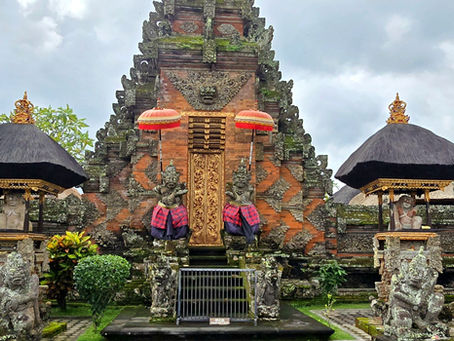top of page

GLOBAL SHANANIGANS

Search


The Royal Palace of Ubud
In the heart of Ubud, the Royal Palace stands as a stunning showcase of Bali’s rich history and artistic spirit. Built around 1640, this elegant complex of pavilions and gardens offers a glimpse into the lives of the island’s royal family while pulsating with cultural performances and traditional ceremonies that keep Ubud’s heritage alive.
Shannon


The Rice Terraces of Tegallalang
Carved like emerald steps into Ubud’s natural amphitheatres, locals say the spirit of the rice goddess still watches over the iconic Tegallalang Rice Terrace, blessing the fields with life and balance. Also known as Ceking, the terraces are a large collection of beautiful verdant rice paddies, carved into the hillside by generations of farmers and shaped by centuries of Balinese ingenuity.
Shannon


Bali’s Buried Past - Blood on the Island of the Gods
One of the most horrific chapters in Balinese history occurred during the anti communist purges which swept across Indonesia in the mid 1960's and barely anyone dares talk about it. In the years leading up to the massacre, Bali was already a fractured island, mirroring the deepening political and social divisions across Indonesia.
Shannon


Taman Ayun - The Royal Playground
Encircled by a wide moat and wrapped in manicured geometric gardens, Pura Taman Ayun looks more like a mythical vision than a temple. This 17th-century royal fortress served as the royal temple of the once mighty Mengwi kingdom and was designed not just to honour the gods but to remind subjects of the divine order that placed kings just beneath them.
Shannon


Campuhan Ridge Walk
On the Campuhan Ridge Walk, gentle paths wind past terraced rice fields, jungle valleys and scattered temples. It’s an effortless stroll, yet every step resonates with the echoes of centuries old Balinese culture.
Shannon


Kehen - The Temple of Fire
First mentioned in ancient copper inscriptions from the 9th century, Kehen Temple was originally known as Pura Hyang Api, a sacred site dedicated to Agni, the Hindu God of fire. This powerful deity symbolises not just destruction but also renewal and purification, embodying the transformative force of flame. Over the centuries, the temple underwent several name changes as it evolved with the shifting tides of Balinese history and spirituality.
Shannon


Sacred Monkey Forest Sanctuary
Hidden among dense jungle in Ubud, the Sacred Monkey Forest is a living tapestry of Balinese culture and nature. Ancient Hindu temples rise amid towering banyan trees, creating an atmosphere of quiet reverence. The forest invites visitors to step into a world where spiritual tradition, wildlife and natural beauty coexist seamlessly, offering a rare glimpse into Bali’s enduring heritage.
Shannon


Pura Dalem Ubud - The Temple of Death
In the shadowed heart of Ubud stands Pura Dalem, a temple steeped in ancient power and shadowed secrets. One of the area’s most formidable sacred sites, it pulses at the centre of the local spiritual life, a place where worship, dark rituals and otherworldly performances unfold. Its moss clad stone carvings depict guardian spirits and fearsome deities, whispering of life, death and the unseen forces that linger at the edge of perception.
Shannon


Yeh Pulu - Water of the Stone Jar
Hidden in a lonely ravine between the Petanu and Pakrisan Rivers, the ruins of this unique 14th-century rock relief lay buried for centuries under volcanic eruptions and vegetation. The site was excavated by Dutch authorities in 1925 and in 1949, a stone gutter was cemented on top in order to drain off water, to prevent erosion and vegetation from taking hold, revealing even more of the stone mural.
Shannon


Gunung Kawi Tampaksiring - The Mountain of Lost Kings
Carved into the rock cliffs on both sides of the Pakrisan River, this 11th century temple site and funerary complex is of profound historical and spiritual significance to the Balinese people. The name Gunung Kawi translates to the "Mountain of Poetry" but it is also affectionately referred to as the Valley of the Kings.
Shannon


Ulu Petanu Waterfall
Tucked deep within Tegallalang village, Ulu Petanu Waterfall offers a peaceful, intimate retreat far from Bali’s busy tourist spots, where crystal-clear waters cascade gently amid dense jungle. Steeped in legend, it is also known as the sacred site linked to King Mayadenawa, whose blood is said to have cursed the nearby river, making the waterfall a place of spiritual cleansing and reverence.
Shannon


Batuan Temple
In the heart of Batuan village stands Pura Puseh Desa Batuan, one of Bali’s oldest and most spiritually charged temples. Founded in 1020 AD and recorded in Balinese historical texts for over a millennium, it is rooted in something far older, believed to have been built atop a megalithic stone circle, echoing the ancient power of Stonehenge, where ancestral rites were once performed.
Shannon


Pura Ulun Danu Batur - The Temple of Ash and Mercy
First established in the 17th century, Pura Batur is one of Bali’s most venerated temples, second only to Pura Besakih on the sacred slopes of Mount Agung. Perched at roughly 900 metres above sea level, this mountain sanctuary overlooks the dramatic caldera of Mount Batur, an active volcano steeped in myth and raw geological power.
Shannon


Besakih Temple
The origins of Pura Besakih are veiled in ancient legend, its story whispered through centuries beyond recorded memory. For more than a thousand years, this sprawling temple complex has stood as the spiritual heart and the “Mother Temple” of the whole island. Perched nearly a kilometre above the sea, on the jagged southwestern flank of Mount Agung, it commands a breathtaking view and an air of sacred power.
Shannon


Goa Garba and the Legacy of Kebo Iwa
Carved into a rugged cliff above the sacred Pakerisan River, this ancient hermitage and unique archaeological site offers a rare glimpse into Bali’s pre Hindu past. Hidden from view, it shelters mysterious megaliths, silent echoes of a time long before Hindu-Buddhist influence shaped the island.
Shannon


Gunung Lebah - The Birthplace of Ubud
Rising from the heart of Ubud, Gunung Lebah Temple was founded in the 8th century by the Indian priest Rsi Markandeya as a sanctuary for meditation and spiritual retreat. Nestled at the confluence of the Wos and Pakerisan rivers, where their waters merge to form the sacred Campuhan, the site hums with serene energy, surrounded by forests rich with medicinal plants believed to heal both body and soul.
Shannon


Fangs of the Divine - Hanuman the Monkey King
Hanuman, the fierce Monkey King, prowls through the shadowed corners of Balinese myth, a figure both revered and feared. Far beyond a mere symbol of strength, he embodies a primal force, wild, untamed and relentless in his pursuit of justice. In Bali’s ancient Hindu-Buddhist tapestry, Hanuman’s presence evokes a raw energy, one that bridges the mortal world with darker realms where gods and demons wage eternal war.
Shannon


Ayutthaya - The Fallen City of Siam
Once the jewel of Siam, Ayutthaya now lies in silence, its streets soaked in blood and its temples crumbling under the weight of history. Execution grounds, ruined chedis, and desecrated monasteries bear witness to the brutal fall at the hands of the Burmese army, where kings, monks, and nobles met violent ends. The shadows of the city are said to whisper with the voices of the betrayed and the slain, a restless reminder that even in ruin, Ayutthaya’s dark legacy refuses to f
Shannon


Thành Chương's Viet Palace
Tucked away on Sóc Sơn Mountain, roughly 30km's north of Hanoi, Thành Chương’s Viet Palace is far more than a museum or art gallery, it is a cultural time capsule and a living work of art, meticulously crafted by the celebrated contemporary Vietnamese painter Thành Chương.
Shannon


Jatiluwih Rice Terraces
The village of Jatiluwih offers a living testament to the ancient harmony between humans, nature and the divine. Overlooked by the brooding silhouette of Mount Batukaru, Bali’s second-highest volcano and a sacred site in its own right, Jatiluwih’s name translates to "truly beautiful," a title it lives up to with dramatic sweeps of emerald-green rice terraces that ripple across the landscape.
Shannon
bottom of page